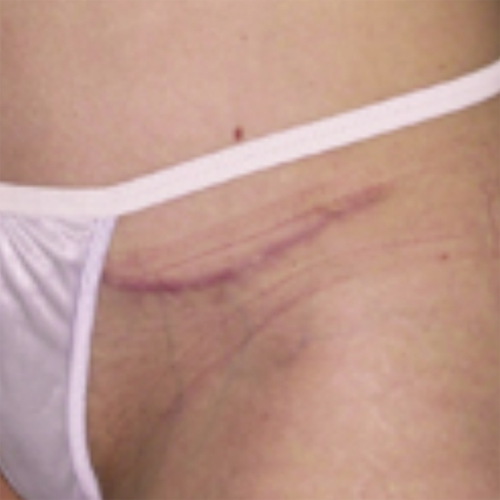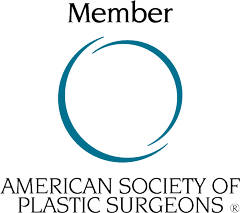
If you have a surgical procedure that involves an incision, a scar will form where the incision was closed. This new scar tissue is formed from myofibroblasts and collagen fibers which are produced by your body in response to the injury. The initial scar formation, referred to as the proliferation phase, can last up to six weeks.
In the final maturation phase, the scar will look and feel different than the surrounding tissue. A normal scar will generally appear somewhat flat and pale and will typically fade with time. In fact, after several years many scars eventually become undetectable to the naked eye.
Why do keloids and hypertropic scars happen?
However, some scars follow a more disruptive path, and can even get worse as time goes on. When the body produces too much collagen in an effort to repair the damage it can result in a ‘raised’ scar. These are considered ‘bad scars’ or ‘adverse scar conditions’ and they can unfold following any incision, including an incision made during a Plastic Surgery procedure.
some scars follow a more disruptive path, and can even get worse as time goes on
While scars are a necessary evil for any Plastic Surgery procedure that has an incision, certain types of scars are worse than others. These undesirable scars are known as hypertrophic scars and keloids.
Both types of scars can be unsightly, but keloids tend to be more pronounced and dramatic as they take on a cauliflower-like look. While keloids are more rare than hypertrophic scars, keloids are also much harder to treat. Proper treatment of either scar type is firmly rooted in correctly diagnosing whether it is a hypertrophic or keloid scar.
Hypertrophic scars

Hypertrophic scars can develop in wounds that were closed under high tension. The term high tension refers to the way that the incision was closed when it was sutured shut (where you were sewn together).
High tension means that the wound closure is stretched tight. This can especially occur in areas where there is a lot of movement. High tension can cause the scar to expand and become thicker. Wounds that are sutured at deeper layers typically have lower tension. Wounds that are closed only at the surface, usually have a higher amount of tension.
Symptoms and Appearance
Hypertrophic scars usually occur within 4-8 weeks following a Plastic Surgery procedure. The original scar becomes raised, but the borders of the scar do not extend beyond the original wound closure margins. In most cases, hypertrophic scars are linear. These scars can resolve with conservative pressure therapy and with time. The other good news is that hypertrophic scars can be eliminated by surgically removing them.
Incidence
The incidence of getting some degree of a hypertrophic scar following a surgical procedure in the general population is 40%-70%. While this is high, there are varying degrees of hypertrophy, and some scars are more acceptable than others.
Keloids

Keloids are irregular looking scars that form after an injury or surgical procedure. Simply put, a keloid is an unsightly scar that oversteps its original borders.
The scar will not only be raised, but it bubbles up beyond the original incision outline. Although there are therapies which can help keloids, they are more difficult to eliminate than hypertrophic scars.
Symptoms and appearance
A keloid scar has a raised and bumpy appearance, which extends past the original scar. In many cases, a keloid can have a cauliflower-like appearance. Keloids can form immediately after the injury or procedure, but can also occur months, or even years after the procedure.
Incidence
Keloids have a very small incidence among the general population, but dark-skinned individuals are much more susceptible. Keloids have an incidence rate of 6-16% in African populations. Family history of keloids is a huge predictor of developing keloids, so anyone with a family history of keloids should be sure to mention it to their Plastic Surgeon prior to their procedure.
Hypertrophic scar vs. Keloid scar
While both scar complications can create cosmetic concerns, there are a few differences worth noting.
What is the main difference?
While a hypertrophic scar is thick and raised, it looks different from a keloid because it does not extend beyond the original margins of the wound. The hypertrophic scar is usually linear, whereas the keloid scar is irregular and cauliflower-like.
Which procedures can get hypertrophic scars or keloids?
Either one of these scars can develop following any procedure where an incision is made. This not only includes procedures with longer incisions such as the abdominoplasty, but also includes any type of ‘lift procedure’ such as breast lifts, body lifts, face lifts, and lip lifts.
Does gender, age, or family history matter?
The occurrence of keloids and hypertrophic scars has equal sex distribution and are most common in the second or third decade of life.
more than 50% of all keloid patients have a family history of keloids
While family history is not a big factor in hypertrophic scars, family history is highly correlated to the incidence of Keloid formation. More than 50% of all keloid patients have a family history of keloid scarring!
Can hypertrophic scars or keloids be prevented?
A Plastic Surgeon can help reduce the risk of hypertrophic scars during surgery and patients can help reduce the risk following their procedure. Some investigators believe that these factors can also help reduce the risk of keloid formation. These techniques include:
Reduce tension at the incision during closure
When an incision is freshly closed with sutures, that closure inherently has ‘tension’ at the closure point. This refers to the forces that exist which naturally want the wound to open back up. In order to reduce tension at the surface of the incision, a surgeon can close the wound with several (deeper) layers, so that the tension (the pulling) is distributed deeper down. This allows the incision at the surface to have the least amount of tension on it. With less tension on the wound, there is less trauma and inflammation on the scar.
In all of my tummy tuck and body lift procedures, I close incisions using the Lockwood technique. This technique uses deep wound closure techniques that results in the least amount of tension at the wound closure on the surface.
Control swelling near the incision site
Following tummy tucks and body lifts all of my patients are instructed to wear compression garments around the clock for at least 14 days. Compression helps greatly to keep post operative swelling to a minimum. When swelling is at a minimum, the scar is less inflamed and has better vascularity. When there is more blood supply and better vascularity, wounds have a better chance of healing without hypertrophic scars and may also help with keloids.
Treatment for hypertrophic and Keloid scars
Pressure therapy has been the preferred conservative management for both the preventive case and treatment of hypertrophic scars and keloids since the 1970’s. In addition, therapies that include steroid injections, silicone gel sheeting, radiotherapy, laser therapy or flavonoids (Madera skin care gel) can provide relief to both hypertrophic and keloid scars. However, hypertrophic scars have a higher success rate with most of these treatments compared to keloids.
Compared to hypertrophic scars, keloids have limited treatment options and can remain problematic for indefinite periods of time.
Most importantly, hypertrophic scars can be successfully eliminated surgically. Keloids are much more difficult to treat surgically as they have a 50% rate of recurrence following excision. However, if keloid excision is accompanied by corticosteroid injections, the success rate of keloid removal can be higher.
Lastly, there are a number of emerging therapies being developed to treat keloids. These include intralesional injections with chemotherapy agents such as Bleomycin and 5-Fluorouacil. You can find information about these therapies in this peer reviewed paper published by Molecular Medicine Journal.
In conclusion
Scarring is always a concern for patients wishing to undergo a plastic surgery procedure to address other concerns. Learn more about what our typical Tummy tuck scars look like or what Breast lift scar options include.
As always, it is important to weigh the pros and cons of elective surgery to determine if the rewards of the procedure outweigh the potential risks, including hypertrophic or keloid scars.
We tend to see very few hypertrophic scars, likely because of the suturing technique noted above and our patients’ commitment to following their post-op instructions. While those factors may also help with preventing keloids, family history is more of a predictor for those and we have been successful treating those for patients who had them occur.
Should scarring complications occur following your surgery, be sure to discuss them with your surgeon since proper diagnosis is imperative for determining the best course of treatment!
(originally posted March 24, 2016)




ludie heath says:
Dr. Ricardo L Rodriguez says: